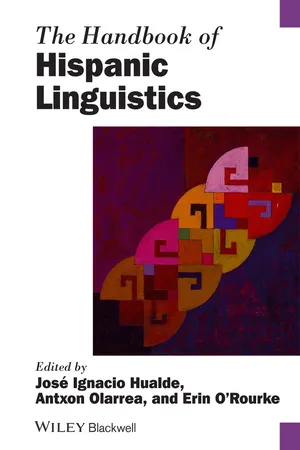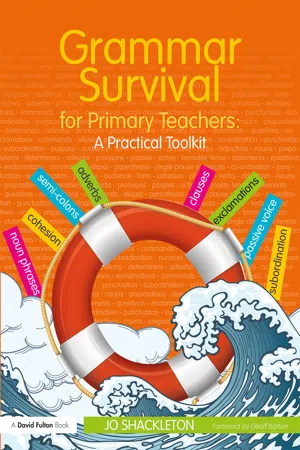Languages & Linguistics
Exclamatives
Exclamatives are linguistic structures used to express strong emotions or exclamations. They often involve an exclamation mark and can take various forms, such as interjections, exclamatory sentences, or exclamatory phrases. Exclamatives are used to convey surprise, excitement, or emphasis in speech and writing.
Written by Perlego with AI-assistance
3 Key excerpts on "Exclamatives"
Learn about this page
Index pages curate the most relevant extracts from our library of academic textbooks. They’ve been created using an in-house natural language model (NLM), each adding context and meaning to key research topics.
- eBook - ePub
- Bas Aarts, April McMahon, Lars Hinrichs, Bas Aarts, April McMahon, Lars Hinrichs(Authors)
- 2020(Publication Date)
- Wiley-Blackwell(Publisher)
let conveys the sense “allow,” serving as more than merely an illocutionary marker. And, even though there is no specific addressee, it is understood that the involvement of the addressee(s) is required.8.7 Exclamatives and Exclamatory Statements
Exclamative clauses feature the fronting of a wh‐phrase (more specifically, a wh‐phrase with how or what, these being the only wh‐items that can express degree), except when the wh‐phrase is subject and therefore already in initial position (see further Siemund 2015 ). In this respect, exclamative clauses are structurally similar to open interrogatives, giving rise to the possibility of ambiguity in abstraction from relevant intonational or punctuational indicators (e.g., What fun lies in store for us meaning either “An exceptional amount of fun lies in store for us!” or “What is the amount of fun that lies in store for us?”). As in interrogatives, the wh‐phrase in Exclamatives can derive from a subordinate clause (e.g., How stupid we thought he looked!) and it can be a prepositional phrase (PP) (e.g., For how long did she put up with his drunken behavior!, though more commonly the preposition is stranded as in How long did she put up with his drunken behavior for!). A further similarity is the possibility of reduction to just the wh‐phrase, as in What a day! and How odd!.Like exclamative how, interrogative how can be used as a degree modifier. However its semantic role within open interrogative clauses is different from that of its exclamative counterpart: in the exclamative How clever he is! we understand that the degree of his cleverness is extraordinary; in the interrogative How clever is he? we understand that his cleverness is simply to be located at some point on a scale of cleverness (precisely where, the speaker anticipates, will be indicated in the answer). Exclamative how is distinctive in two further respects: unlike interrogative how it can modify another degree modifier (compare How very clever he is! with *How very clever is he? - eBook - ePub
- José Ignacio Hualde, Antxon Olarrea, Erin O'Rourke, José Ignacio Hualde, Antxon Olarrea, Erin O'Rourke(Authors)
- 2012(Publication Date)
- Wiley-Blackwell(Publisher)
In this section we will consider different illocutionary acts that interrogative sentences may have. Syntactically speaking, all the examples in (17) are interrogatives, and as such, they have the sentential force of asking. However, their illocutionary forces are different. The illocutionary forces are shown in the parentheses following the example. We cannot include here an exhaustive list of all the possible illocutionary forces for interrogatives. However, all we need to observe here is that there is no one-to-one correspondence between sentential type (the linguistic structure we use) and illocutionary force (the communicative action we intend to perform).(17)a. ¿Te tomarías un cafecito conmigo? (invitation) ‘Would you (like to) have a coffee with me?’ b. ¿Me pasas la sal? (request) ‘Can you pass me the salt?’ c. ¿Vamos al cine esta tarde? (suggestion/invitation) ‘Shall we go to the movies tonight?’ d.¿Te molesta el humo? (permission) ‘Does smoke bother you?’ (i.e., Do you mind if I smoke?) 3.3 Exclamative type
Parallel to what we observed for interrogatives in Section 2.1, exclamative force has two basic syntactic realizations: “total Exclamatives” (Sp. exclamativas totales ) and “partial Exclamatives” (Sp. exclamativas parciales ) (NGDLE: s. 42.14, s. 32.2). Zanuttini and Portner (2003) argue that there is no syntactic element introducing exclamative force. In their system, Exclamatives are the result of the co-occurrence of a factive and a WH operator. Thus, examples like (18a) would not qualify as Exclamatives, but as declaratives. Following the RAE, I will take a more conservative approach, and assume that there is an exclamative force that allows for the realization of both types of Exclamatives in (18).Regarding their sentential and illocutionary force, they are typically used for expressing emotional reaction (surprise, annoyance, exclamation, etc.). Total Exclamatives look like declarative sentences, but they differ in intonation and by the fact that we write them between exclamation marks, as shown in (18a). Partial Exclamatives appear with interrogative/exclamative words, as shown in example (18b). Note that the adverb tan ‘so’ is used in Exclamatives but not in declaratives.(18) a. ¡Estoy (tan/muy/re-/requete) cansado! ‘I-am (so/very/very/very) tired!’ b. ¡Qué cansado estoy! What tired I-am ‘I am so tired!’Partial Exclamatives are much more frequent in Spanish than they are in English. Partial Exclamatives typically invert the subject and the object. Apart from qué ‘what,’ we also find the interrogative words cuánto(a)(s ) ‘how much/many’ (19a,b), comó ‘how’ (19b), and cuán - eBook - ePub
Grammar Survival for Primary Teachers
A Practical Toolkit
- Jo Shackleton(Author)
- 2017(Publication Date)
- Routledge(Publisher)
Exclamations are usually demarcated by an exclamation mark (!). Other forms of sentence (such as commands or statements) can also be demarcated by an exclamation mark: writers tend to do this when they want to add emotive force or emphasis, or to show that a character is shouting:‘Look out!’ yelled Tommy. There was a terrific thunderstorm and we got drenched! However, the use of an exclamation mark doesn’t make these sentences exclamations: they are still commands or statements. p.51 APPLICATIONTeaching about exclamationsIt’s important to remember that the national curriculum specifies sentences with different forms, so pupils need to be aware of the differences between one-word interjections, exclamative phrases and sentences.Exclamations tend to be less widely used than the other sentence forms, so you can’t necessarily rely on pupils being exposed to them in everyday situations. You’ll often find exclamations in traditional tales and poems such as Little Red Riding Hood and The Owl and the Pussycat.• What big teeth you have, Grandma! • How charmingly sweet you sing!You can draw attention to these through your work on storytelling and poetry performance so that pupils absorb the patterns and rhythms of this sentence form. Pupils can make up their own exclamations by substituting one or two words from a given example: What big teeth you have, Grandma! might become What long hair you have, Sally! or What great stories he tells! A single sentence can provide pupils with a model which they can then adapt and use in their own writing, whenever appropriate.You could use a more ‘hands-on’ inductive approach by giving pupils a selection of sentences on cards. You might restrict these to questions and exclamations that start with ‘what’ or ‘how’, depending on how much your pupils already know about sentence forms. It’s best to leave off the question marks and exclamations marks, but do tell your class that you’ve done this! Ask pupils to sort the cards into questions and exclamations. (Ideally, this is done in pairs or threes so that they can talk about the reasons for their choices.) It might help to provide a clue, e.g. In the questions, the word ‘what’ is followed by a verb; in the exclamations, it is followed by a noun or a noun phrase.


